
Worcestershire is a ceremonial county in the West Midlands of England. It is bordered by Shropshire, Staffordshire, and the West Midlands county to the north, Warwickshire to the east, Gloucestershire to the south, and Herefordshire to the west. The city of Worcester is the largest settlement and the county town.

Kidderminster is a market town and civil parish in Worcestershire, England, 20 miles (32 km) south-west of Birmingham and 12 miles (19 km) north of Worcester. Located north of the River Stour and east of the River Severn, in the 2021 census, it had a population of 57,400. The town is twinned with Husum, Germany.

Belton House is a Grade I listed country house in the parish of Belton near Grantham in Lincolnshire, England, built between 1685 and 1687 by Sir John Brownlow, 3rd Baronet. It is surrounded by formal gardens and a series of avenues leading to follies within a larger wooded park. Belton has been described as a compilation of all that is finest of Carolean architecture, said to be the only truly vernacular style of architecture that England had produced since the Tudor period. It is considered to be a complete example of a typical English country house; the claim has even been made that Belton's principal façade was the inspiration for the modern British motorway signs which give directions to stately homes.
Sir Henry Herbert was Master of the Revels to both King Charles I and King Charles II, as well as a politician during both reigns.

Bewdley is a town and civil parish in the Wyre Forest District in Worcestershire, England on the banks of the River Severn. It is in the Severn Valley, and is 3 miles (4.8 km) west of Kidderminster, 10 miles (16 km) North of Worcester and 25 miles (40 km) southwest of Birmingham. It lies on the River Severn, at the gateway of the Wyre Forest national nature reserve, and at the time of the 2011 census had a population of 9,470. Bewdley is a popular tourist destination and is known for the Bewdley Bridge, designed by Thomas Telford, and the well preserved Georgian riverside.

Stourport-on-Severn, often shortened to Stourport, is a town and civil parish in the Wyre Forest District of North Worcestershire, England, a few miles to the south of Kidderminster and downstream on the River Severn from Bewdley. At the 2021 census, it had a population of 20,653.
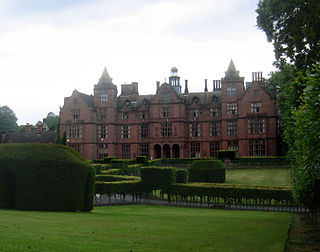
Hewell Grange is a former country house in Tardebigge, Worcestershire, England. "One of the most important late 19th century country houses in England", the mansion was built between 1884 and 1891 by George Frederick Bodley and Thomas Garner for Robert Windsor-Clive, later first Earl of Plymouth. Constructed in the Jacobethan style, it was "perhaps the last Victorian prodigy house". After the Second World War, the third earl sold the Hewell estate to the Crown and it was redeveloped as a prison. The mansion was used to house young offenders, and later low-risk prisoners, while adult prisons were built in the grounds. The site was subsequently consolidated as HM Prison Hewell. In 2019, the Ministry of Justice announced the closure of the Category D open prison housed in Hewell Grange, after a highly critical report by Her Majesty's Inspectorate of Prisons.

Bewdley Town Football Club is a football club based in Bewdley, Worcestershire, England. They are currently members of the Midland League Premier Division and play at Ribbesford Meadows.

Wyre Forest is a local government district in Worcestershire, England. It is named after the ancient woodland of Wyre Forest. The largest town is Kidderminster, where the council is based. The district also includes the towns of Stourport-on-Severn and Bewdley, along with several villages and surrounding rural areas.

Julius Alfred Chatwin FRIBA, ARBS, FSAScot was a British architect. He was involved with the building and modification of many churches in Birmingham, and practised both Neo-Gothic and Neo-Classical styles. His designs always included all of the carvings and internal fittings.
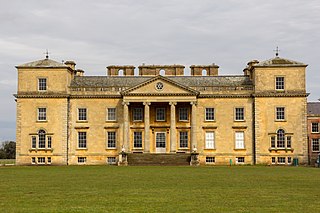
Croome Court is a mid-18th-century Neo-Palladian mansion surrounded by extensive landscaped parkland at Croome D'Abitot, near Upton-upon-Severn in south Worcestershire, England. The mansion and park were designed by Lancelot "Capability" Brown for the 6th Earl of Coventry, and they were Brown's first landscape design and first major architectural project. Some of the mansion's rooms were designed by Robert Adam. St Mary Magdalene's Church, Croome D'Abitot that sits within the grounds of the park is now owned and cared for by the Churches Conservation Trust.
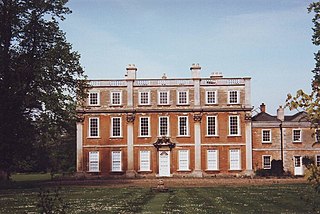
Hinwick House is a Grade I-listed Queen Anne country house located about 90 minutes from Central London, near Podington in North Bedfordshire. The estate consists of the Queen Anne main house, the Victorian wing, the Victorian wing extension, garage block, stables, three cottages attached to a clock tower, a walled garden and a period dovecote. The house and estate has a total of 50 rooms. Hinwick House underwent a two-year restoration programme that concluded in 2016.
The Bewdley School is a senior school and sixth form in Bewdley, serving north-west Worcestershire, England. Its campus is very close to the River Severn and lies on the border of the Wyre Forest national nature reserve. Bewdley is an educational research partner of the University of Worcester and University of Birmingham and is recognised for its focus on international and cultural education. In 2019, Bewdley hosted the Global Happiness Conference in partnership with the British Council. The Bewdley School has close ties with the nearby Bewdley Rowing Club established in 1877.

Ribbesford is a village and civil parish in the Wyre Forest District of Worcestershire, England. It had a population of 237 in the 2001 census.

Bredon School, formerly Pull Court, is a private school in Bushley, Worcestershire, England. The house was built for the Reverend Canon E. C. Dowdeswell by Edward Blore between 1831 and 1839. The site is much older and Blore's house replaced an earlier mansion. The Dowdeswells had been prominent in local and national politics since the 18th century, with many serving as members of Parliament. The family sold the house in 1934 to the parents of Richard Seaman, a prominent pre-war racing driver, who lived there until his death in a crash in the 1939 Belgian Grand Prix. In 1962, the court became a school, Bredon School, founded by Lt-Col Tony Sharp and Hugh Jarrett, for the education of boys who had failed the Common Entrance Examination. It remains a specialist school with a focus on educating children with specific learning difficulties, such as dyslexia and dyspraxia.
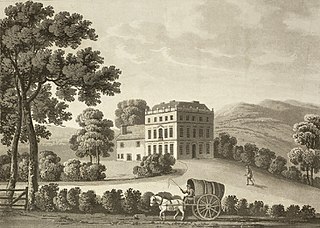
Stoke Hall is a Grade II* listed 30-room Georgian Palladian mansion near the village of Grindleford, Derbyshire, England, whose restoration featured on the BBC series Restoration Home and the follow-up Restoration Home - One Year On.

Burford House is an 18th-century country house in Burford, Shropshire, near Tenbury Wells, Worcestershire, England. It now functions as a garden centre, cafe, garden and retail outlet.

Bewdley Guildhall is a municipal building in Load Street in Bewdley, Worcestershire, England. The structure, which is the meeting place of Bewdley Town Council, is a Grade II* listed building.

St Wulstan's Roman Catholic Church, Little Malvern, Worcestershire, England is a Benedictine parish church administered by the monks of Downside Abbey. The attached churchyard contains the grave of the composer Edward Elgar and of his wife, Alice. The church was designed in 1862 in a Gothic Revival style by Benjamin Bucknall. It is a Grade II listed building. The Elgars' grave has a separate Grade II listing.
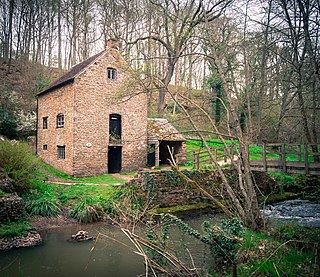
Knowles Mill is the remains of an eighteenth-century water-powered grain mill, located in the Wyre Forest in Worcestershire, England. The mill has been owned by the National Trust since 1938. The mill and its surroundings feature extant machinery, as well as notable populations of adders and wood cranesbill.





















